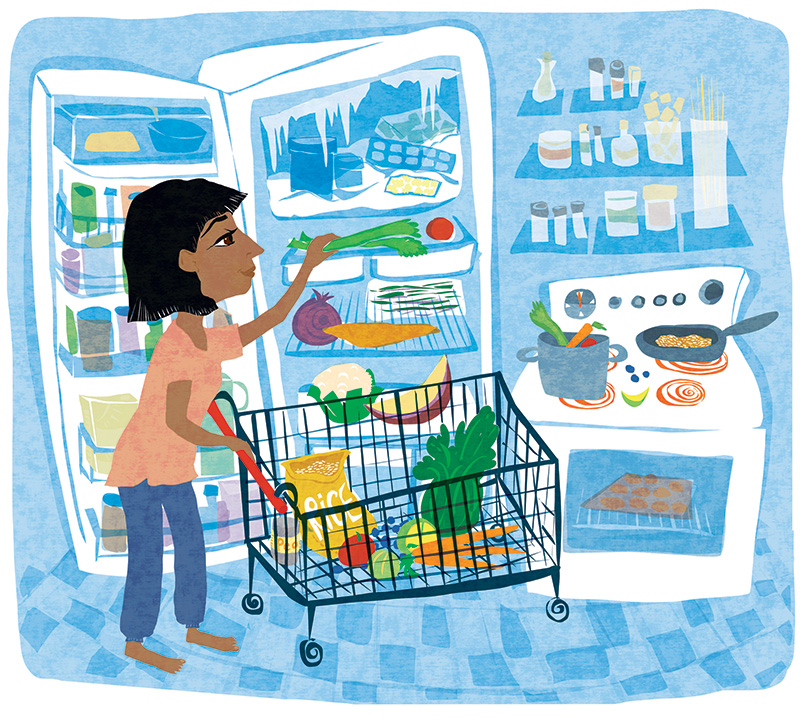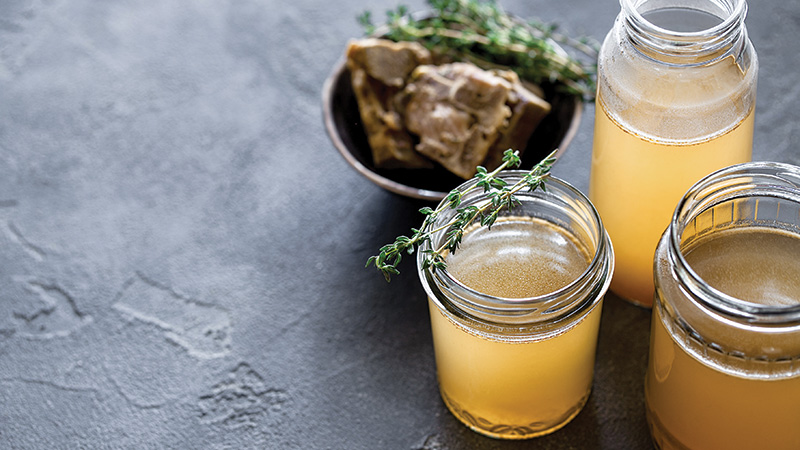The Eye-Opening Joys of Eating Down the Fridge
By Kim O’Donnel, guest contributor
This article was originally published in March 2022

Illustrated by Wendy Wahman
Thirteen springs ago, this 40-something food writer and culinary grad ventured into unknown territory: a week of cooking solely from the pantry, without the convenience of grocery shopping at will. As a cooking columnist/blogger at washingtonpost.com, I announced an “Eating Down the Fridge” challenge and proposed that my readers come along for the ride.
Already feeling the sting of that era’s financial crisis, I sought out kitchen conservation measures earlier generations had practiced in the Great Depression. I found modern inspiration from a similar “week without shopping” challenge from eGullet, the digital community forum co-founded by the late food writer Steven Shaw.
What at first felt like a fun diversion quickly morphed into an eye-opening and game-changing experience. I remember marveling at my pantry as if it were a mythological world, where cans of tuna and black beans magically reproduce and a junkyard dog keeps watch over the heaps of opened pasta boxes. I needed sunglasses to reduce the glare of the bulging skyline of condiments inside the refrigerator door and a headlamp to navigate the dense tundra of the freezer.
No wonder I had often felt as if there was nothing to eat. I literally couldn’t see what was in front of me.
As I got reacquainted with what I had on hand, the cooking came easily and the possibilities seemed endless: Vegetable crisper remnants transformed into star-studded frittatas and stir fries. Leftover mashed potatoes became the stuff of canned salmon croquettes. Now that I could see, the possibilities were endless.
When the pandemic brought the world to a standstill in the spring of 2020, I was reminded of that experiment and realized that it was a dress rehearsal for these uncertain times. I was fortunate enough to have a house full of food; I just couldn’t go grocery shopping whenever I wanted.
My pantry hoarding reflects the paradox of our land of plenty, where 38 million Americans were food insecure in 2020. While nearly 12% of the population goes hungry, about 35% of the U.S. supply never gets eaten, much of which ends up in landfills. As much as that wake-up call 13 years ago taught me, I must confess: I still pressed the proverbial snooze button. Can I make up for lost time and heed that call? As the planet teeters closer to irreversible environmental damage, my grace period is over.
The time is now to make friends with our respective pantries and use them like we mean it. An eating down the fridge challenge is a great ice breaker. When you’re ready to take this relationship to the next level, you can delve into a world of repurposing that will make you partners for life. Who’s with me?
Step One: Eat Down the Fridge (and Pantry)
Start with a week-long challenge, with the permission to pause and restart. This is a process and hopefully the beginning of a long and beautiful relationship. Go gradually and go easy on yourself.
As you take inventory and separate the edible from the unrecognizable, consider hosing down those long-ignored shelves and drawers before restocking. A sparkly clean pantry and refrigerator can be a powerful motivator.
Consider enlisting a friend or neighbor to join you in the challenge—someone who can share your wins, trade pantry items and keep you honest. The more the merrier; think of the meal exchange possibilities.
If on Day 6, you see many more pantry meals in your future, keep going. You will become more nimble and resourceful, rotating and using up inventory like an experienced chef. With time, you’ll know instinctively that a half sleeve of saltine crackers, pulverized, makes stellar breadcrumbs and that six or eight apples that have lost their crunch cook down into the best applesauce in about 15 minutes. You may find yourself pouring the juice from brown limes into ice cube trays and turning that scraggly ginger into a sublime simple syrup. The dribs, drabs and leftovers become possibilities rather than extra baggage.
To keep your new skills sharp, consider doing a pantry challenge on a quarterly or biannual basis. More than 100 households nationwide joined me on that initial 2009 experiment; many of us kept it as an ongoing tradition.
Step two and beyond: get a handle on your greens
Part of eating down the fridge means lengthening the lifespan of what’s inside. Think about how dry pre-washed greens are—and how most head lettuce in the produce aisle is not. We all know the drill, the one in which we stuff lettuce into plastic produce bags (note: PCC continues to test and seek out compostable options), pooling with water by the time we get home. While unpacking groceries, we jam those bags into the refrigerator crisper drawer, which I often think of as the lettuce graveyard. Instead:
Remove the metal twist tie if you have used one, along with any decaying leaves or stems. Remove any water inside the storage bag, wrap the greens in a kitchen towel, then back into the bag. If that’s all you have time for, the greens will repay you with an extended shelf life. The rewards are even more handsome if you wash and dry the greens before the towel step.
Grow your own herbs. Break the cycle of dependence on the 1-ounce plastic clamshell and become your own supplier! Having your own backyard or windowsill stash isn’t just less expensive, it’s liberating and inspires creativity.
Rescue fresh spinach and other quick-cooking greens with the shrinky-dink trick. When you steam spinach and blend it with a small amount of oil, you change its composition from refrigerator slime prey to a versatile, ready-to-cook puree. It’s a revelation (details below).
Become a bone (and shell) collector
Avid home cooks know that broth is the foundation of soups, stews, rice dishes and so much more. The key is in remembering to pause before composting our favorite bones, shells (and other “bony” matter) and repurpose into homemade broth, for now or later. You’ve done most of the work to get to this point; why not keep going? Don’t forget to label and date!
Poultry-loving people: Next time you buy a whole chicken, consider the butterfly/spatchcock twofer. By removing the backbone with shears, you help the chicken to splay out and cook more efficiently. Store the first backbone in a freezer-friendly container or bag; when you have accumulated three or four, you’re ready to make stock.
If you already are going to the trouble of peeling shrimp, you have done most of the work for shrimp stock. Take those shells on a compost detour and throw them into a medium saucepan. Add enough water to cover. Bring to a boil, then reduce the heat to low and cover. Cook at a simmer for 30 minutes. Strain and completely cool before storing. Freezes well.
Steamed clams are typically cooked in very little water, but if you’re after clam broth, adding a few cups of water to the pot does the trick. For every 5 pounds of clams, add about 2 cups of water. (A few stalks of chopped celery or fennel fronds is a nice addition.) When the clam shells have opened (5 to 10 minutes), remove from the pot. Strain the resulting broth (it will be gritty), then taste. Dilute with water as needed, but remember, the broth’s job is to season the next dish.
Honestly, the easy-peasy onion skin broth recommended by your favorite old-school vegetarian tastes like crayon water. But a broth made from a few leeks taking up space in the crisper drawer? That I can get behind. (Be sure to thoroughly wash the leeks, which notoriously harbor sand in between layers.)
All the broths will freeze well—just remember to use them up for those stews, rice dishes or other meals before the next Eating Down the Fridge challenge comes along!
TAKE A CLASS
Kim O’Donnel will teach an online class on “Cooking Without Recipes: Reducing Waste in the Kitchen” on April 18.
Sign Up

Chicken Bone Broth
2 pounds chicken bones (this can be reserved backbones or a combination of chicken feet, wings and backs)
8 cups cold water, plus more as needed
1 large leek, washed, root removed and cut into chunks or 1 medium onion, skin on and quartered
4 to 6 parsley stems
1 tablespoon black peppercorns
Place the bones and water in a large pot. The water should cover the bones by about 2 inches; add more as needed. Add the leek and other aromatics.
Bring to a boil. With a slotted spoon or fine sieve, remove the foam that rises to the top. You may notice how the foam clings to the leeks and parsley, the work of the chloropyll as stock purifier.
Reduce the heat to medium-low, cover and cook at simmer for at least 2 hours (and up to 4). The longer you cook, the deeper the flavor. Completely cool, then strain. Refrigerate or freeze.
Spinach Bhaji
Adapted from “World Vegetarian” by Madhur Jaffrey
This is a versatile house favorite, playing nicely with lentils, chickpeas, roasted potatoes, your favorite grain or grilled protein.
2 tablespoons neutral oil
1 cup roughly chopped onion
½ jalapeno chile pepper, seeded and minced, or more if you want spicier results
1 clove garlic, finely chopped
1 cup shrunken spinach puree
¼ to ½ teaspoon salt
Place the oil in a large skillet set over medium heat, tilting until the surface is coated. Add the onion and cook until softened, about five minutes.
Add the garlic and chile pepper, stirring until mixed, about 1 minute. Lower the heat to medium-low and add the spinach puree, stirring until well coated. Cook uncovered, until the liquid has nearly disappeared, about 2 minutes. Season with salt and serve hot.
Shrunken spinach puree
Spinach contains more than 90% water by weight, which means it shrinks considerably in volume, even after 90 seconds of cooking.
Makes 1 cup
8 cups leaf spinach
1 tablespoon olive oil
Thoroughly wash the spinach, making sure it is free of silt. Remove stems as needed.
Steam the spinach. You can do this with a stovetop steamer insert or basket or in a microwave. If using a microwave, cook for about 90 seconds. Turn with tongs and let cool. You do not need to drain. Place in a stand blender or food processer with the oil and blend until pulverized. Use right away or store in an airtight jar in the refrigerator, where it will keep for about two days. Freezes well.
